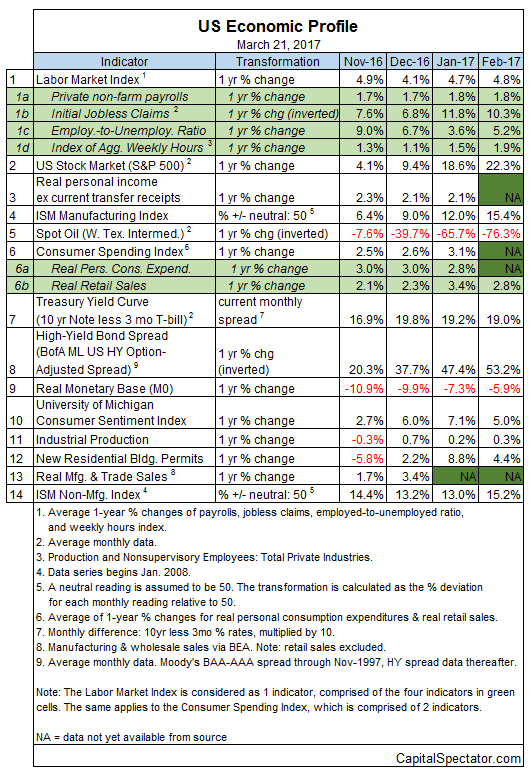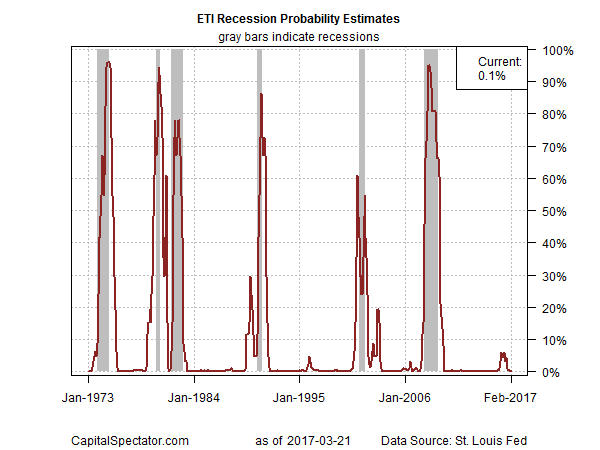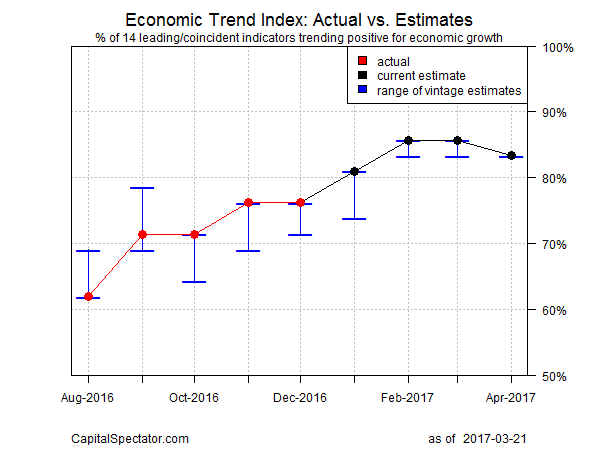Recession risk remains low for the US, but there are hints that the sluggish pace of growth in last year’s fourth quarter may continue in Q1.
Last week’s revised first-quarter estimate of GDP growth slipped to a weak 0.9%, based on the March 17 update of the Atlanta Fed’s GDPNow model – well below the sluggish 1.9% increase in 2016’s final quarter. But is that worrisome estimate excessive? Yes, according to alternative data sources, including The Wall Street Journal’s economic survey for this month, which anticipates GDP growth in Q1 will hold steady at 1.9%, based on the average estimate among economists. Meanwhile, the New York Fed’s current Q1 projection for growth is substantially higher at 2.8% (March 17).
The near-term economic outlook may be in flux at the moment, but forward momentum still appears strong enough to keep recession risk to a minimum, based on the macro profile through February. Data published to date continues to show that the probability of an NBER-defined recession is virtually nil. The Capital Spectator’s proprietary business-cycle indexes continue to signal low business-cycle risk through last month.
For the nearly complete February profile, just two of 14 indicators in our model are weighing on the broad trend: oil (via sharply higher prices in year-over-year terms) and the ongoing contraction in the monetary base in real terms. Otherwise, the remaining numbers paint an upbeat profile. (For a more comprehensive read on business-cycle analysis on a weekly basis, see The US Business Cycle Risk Report.)
Yesterday’s February update of the Chicago Fed National Activity Index tells a similar story. The benchmark’s three-month average increased to +0.25 last month, the highest reading in more than two years and far above the -0.70 tipping point that marks the start of new recessions. Based on the bank’s index, it’s reasonable to wonder if Q1 GDP growth may turn out to be stronger than economists are expecting.

Aggregating the data in the table above continues to reflect a broad trend that remains comfortably positive. The Economic Trend and Momentum indices (ETI and EMI, respectively) edged higher in February, building on a rebound that started in last year’s second half. As a result, both benchmarks remain well above their respective danger zones: 50% for ETI and 0% for EMI. When/if the indexes fall below those tipping points, we’ll have clear warning signs that recession risk is at a critical level, in which case a new downturn will be likely. The analysis is based on a methodology outlined in my book on monitoring the business cycle.

Translating ETI’s historical values into recession-risk probabilities via a probit model also points to low business-cycle risk for the US through last month. Analyzing the data with this methodology shows that the numbers continue to imply that the odds are virtually nil that NBER will declare February as the start of a new recession.

For perspective on looking ahead, consider how ETI may evolve as new data is published. One way to project future values for this index is with an econometric technique known as an autoregressive integrated moving average (ARIMA) model, based on calculations via the “forecast” package for R. The ARIMA model calculates the missing data points for each indicator for each month — in this case through April 2017. (Note that December 2016 is currently the latest month with a full set of published data.) Based on today’s projections, ETI is expected to tick lower next month but remain well above its danger zone by staying far above the 50% mark.

Forecasts are always suspect, but recent projections of ETI for the near-term future have proven to be relatively reliable guesstimates vs. the full set of published numbers that followed. That’s not surprising, given ETI’s design to capture the broad trend based on multiple indicators. Predicting individual components, by contrast, is prone to far more uncertainty.
The assumption here is that while any one forecast for a given indicator will likely be wrong, the errors may cancel out to some degree by aggregating a broad set of predictions. That’s a reasonable view according to the generally accurate historical record for the ETI forecasts in recent years.
The current projections (the four black dots in the chart above) suggest that the economy will continue to expand. The chart above also includes the range of vintage ETI projections published on these pages in previous months (blue bars), which you can compare with the actual data (red dots) that followed, based on current numbers.
Note: ETI is a diffusion index (i.e., an index that tracks the proportion of components with positive values) for the 14 leading/coincident indicators listed in the table above. ETI values reflect the 3-month average of the transformation rules defined in the table. EMI measures the same set of indicators/transformation rules based on the 3-month average of the median monthly percentage change for the 14 indicators. For purposes of filling in the missing data points in recent history and projecting ETI and EMI values, the missing data points are estimated with an ARIMA model.
